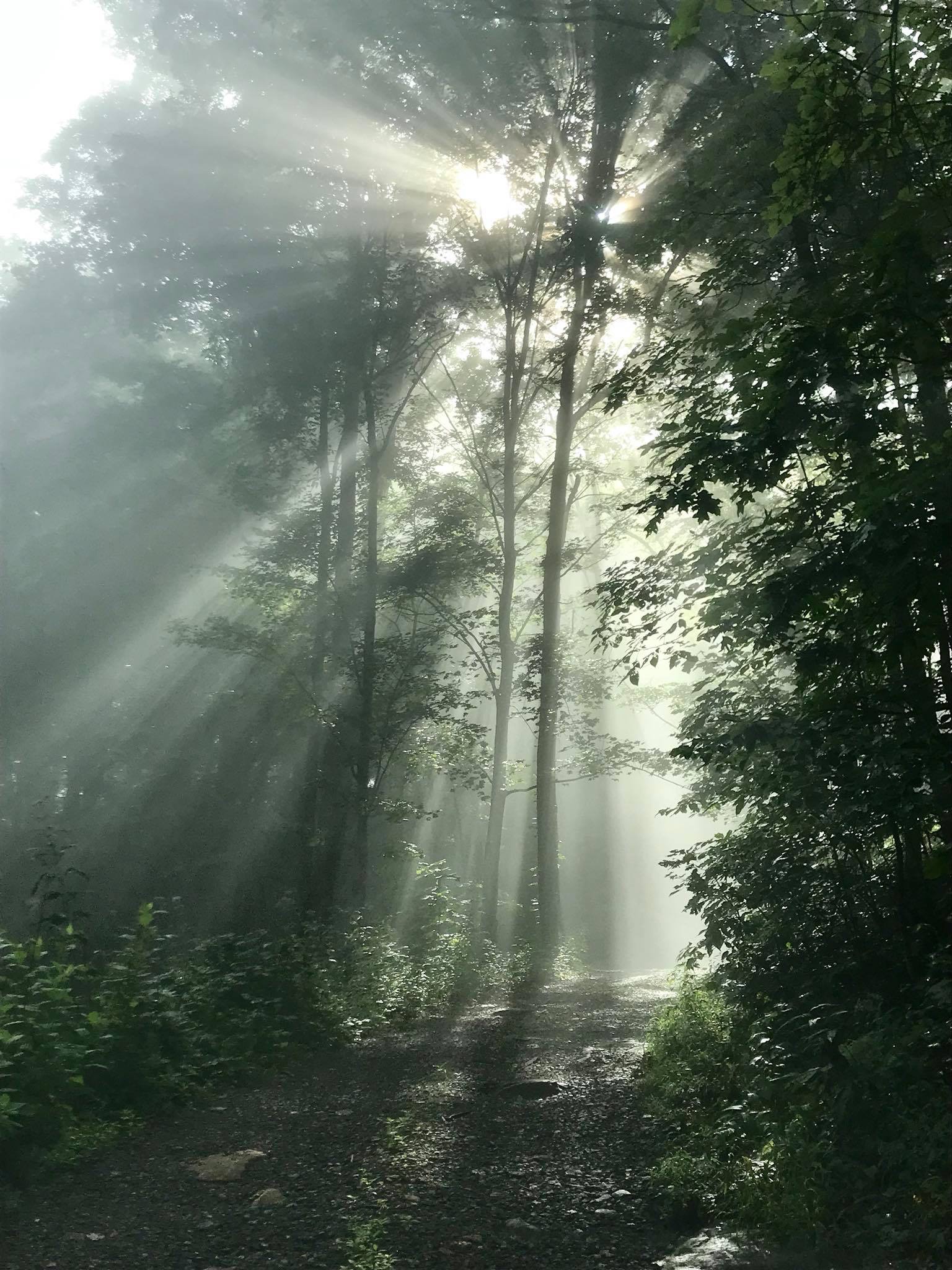Come journey with us as we explore and highlight the people and places that make the Blue Ridge and Southern Appalachian Mountains special and unique
![]()
![]()

Years of careful study has proven that spending time in a forest can reduce stress, anxiety, depression and anger; strengthen the immune system, improve cardiovascular and metabolic health and boost overall well-being. Exploration Local Host, Mike Andress, discusses his own personal struggle with depression and anxiety and the freedom he experiences from being in the outdoors. He shares some helpful resources like The Nature Fix and Forest Bathing that open the door to the modern affliction of “nature deficit disorder” and research that supports the health benefit claims of the healing properties of “nature therapy”.
The term emerged in Japan in the 1980s as a physiological and psychological exercise called shinrin-yoku (“forest bathing” or “taking in the forest atmosphere”). The purpose was twofold: to offer an eco-antidote to tech-boom burnout and to inspire residents to reconnect with and protect the country’s forests.
As Florence Williams writes, “The renewed interest of late represents a convergence of ideas and events: the relentless march of obesity, depression and anxiety (even in affluent communities and despite more medication), the growing recognition of the role of the environment on genes, and the growing academic and cultural unease with our widening breach from the outdoors”. She goes on to say that, “Scientists are quantifying nature’s effects not only on mood and well-being, but also on our ability to think—to remember things, to plan, to create, to daydream and to focus—as well as on our social skills.”
I am not exactly sure who you would credit as the first founder of shinrin-yoku but the two primary influencers and thought leaders I have come across are Yoshifumi Miyazaki and Qing Lee. They are are on a quest to quantify nature’s effects on our health and well being. In 1982, Japan launched a national program to encourage forest bathing and in 2004, a formal study of the link between forests and human health began in Iiyama, Japan—a place particularly known for its lush, green forests. Now, each year upwards of 2.5 million people walk those forest trails as a way to ease stress and enhance health.
Japan’s Forestry Agency is completely on board evidences by the fact that they have funded about $ 4 million in forest-bathing research since 2003 AND it intends to designate one hundred Forest Therapy sites within ten years.
William’s believes its probably because we’re losing our connection to nature more dramatically than ever before. Thanks to a confluence of demographics and technology, we’ve pivoted further away from nature than any generation before us. At the same time, we’re increasingly burdened by chronic ailments made worse by time spent indoors, from myopia and vitamin D deficiency to obesity, depression, loneliness and anxiety, among others.
If there was one man who can demonstrate how forest therapy works, it’s Yoshifumi Miyazaki.
I don’t mean to simplify Forest Bathing but the best analogy I can think of is a weekend in the woods where you have no distractions and you are able to be present in the moment either by yourself or with loved ones. The research component of this would be to undergo a series of tests to determine the positive effects of the experience.
The scientific piece is probably best understood in the words of Florence Williams where she writes…
In gauging our physiological responses to these environments, Miyazaki and Lee look at changes in blood pressure, pulse rate, variable heart rate, salivary cortisol and, new this year, hemoglobin in the brain’s prefrontal cortex. When aggregated, these metrics paint a picture of our bifurcated nervous system. When we are relaxed and at ease in our environment, our parasympathetic system—sometimes called the “rest and digest” branch—kicks in. This is why food tastes better in the outdoors, explains Miyazaki. But the demands and constant stimuli of modern life tend to trigger our sympathetic nervous system, which governs fight-or-flight behaviors. And trigger it, and trigger it. We suffer the consequences: a long trail of research dating back to the 1930s shows people who produce chronically high cortisol levels and high blood pressure are more prone to heart disease, metabolic disease, dementia and depression. More recent research shows that the steady stress of urban living changes the brain in ways that can increase our odds of schizophrenia, anxiety and mood disorders.
In the book, Williams also writes about A young psychologist named Roger Ulrich was curious why so many Michigan drivers chose to go out of their way to take a tree-lined roadway to the mall. In 1986, using the expensive and cumbersome equipment of the time, he hooked up an electroencephalograph (EEG) unit to the heads of healthy volunteers while they viewed slides of nature scenes or utilitarian urban buildings.
The subjects assigned to nature showed higher alpha wave activity, a wavelength associated with relaxation, meditation and increased serotonin. In another experiment, he stressed out 120 students by showing them movies of bloody accidents in a woodworking shop. He knew they were distressed because he measured their sympathetic nervous activity—the sweat glands on their skin, their heart rates and their blood pressure. Afterward, some students were assigned to watch a ten-minute video of nature scenes and some to watch videos of urban scenes, from a pedestrian mall to cars on a road. The results were dramatic: within five minutes, the brains-on-nature returned to baseline. The brains-on-built-environment recovered only partway—as indicated by those nervous system measures—even more than ten minutes later.
Do they just get wiped out by the first traffic jam or cell phone tone? Miyazaki’s sometime collaborator, an immunologist in the department of environmental medicine at Nippon Medical School in Tokyo, wondered the same thing. Qing Li is interested in nature’s effect on mood states and stress as manifested in the human immune system. Specifically, he studies natural killer immune cells, called NK cells, which protect us from disease agents and can, like cortisol and hemoglobin, be reliably measured in a laboratory. A type of white blood cell, they’re handy to have around, since they send self-destruct messages to tumors and virus-infected cells. It’s been known for a long time that factors like stress, aging, and pesticides can reduce your NK count, at least temporarily. So, Li wondered, if nature reduces stress, could it also increase your NK cells and thereby help you fight infections and cancer? To find out, Li brought a group of middle-aged Tokyo businessmen into the woods in 2008. For three days, they spent a couple of hours each morning hiking. By the end, blood tests showed their natural killer cells had increased 40 percent. Moreover, the boost lasted for seven days. A month later, their NK count was still 15 percent higher than when they started. In contrast, during urban walking trips of the same duration, NK levels didn’t change.
After years of careful study, Li has found that spending time in a forest can reduce stress, anxiety, depression, and anger; strengthen the immune system; improve cardiovascular and metabolic health; and boost overall well-being.
Why Forest Bathing Is Good For You
Forest Walking Affects Autonomic Nervous Activity: A Population-Based Study
Negative Ions Create Positive Vibes
The Waterfall Effect: Negative Ions Give Positive Results
Suicide Prevention Hotline
Depression Hotline Number
